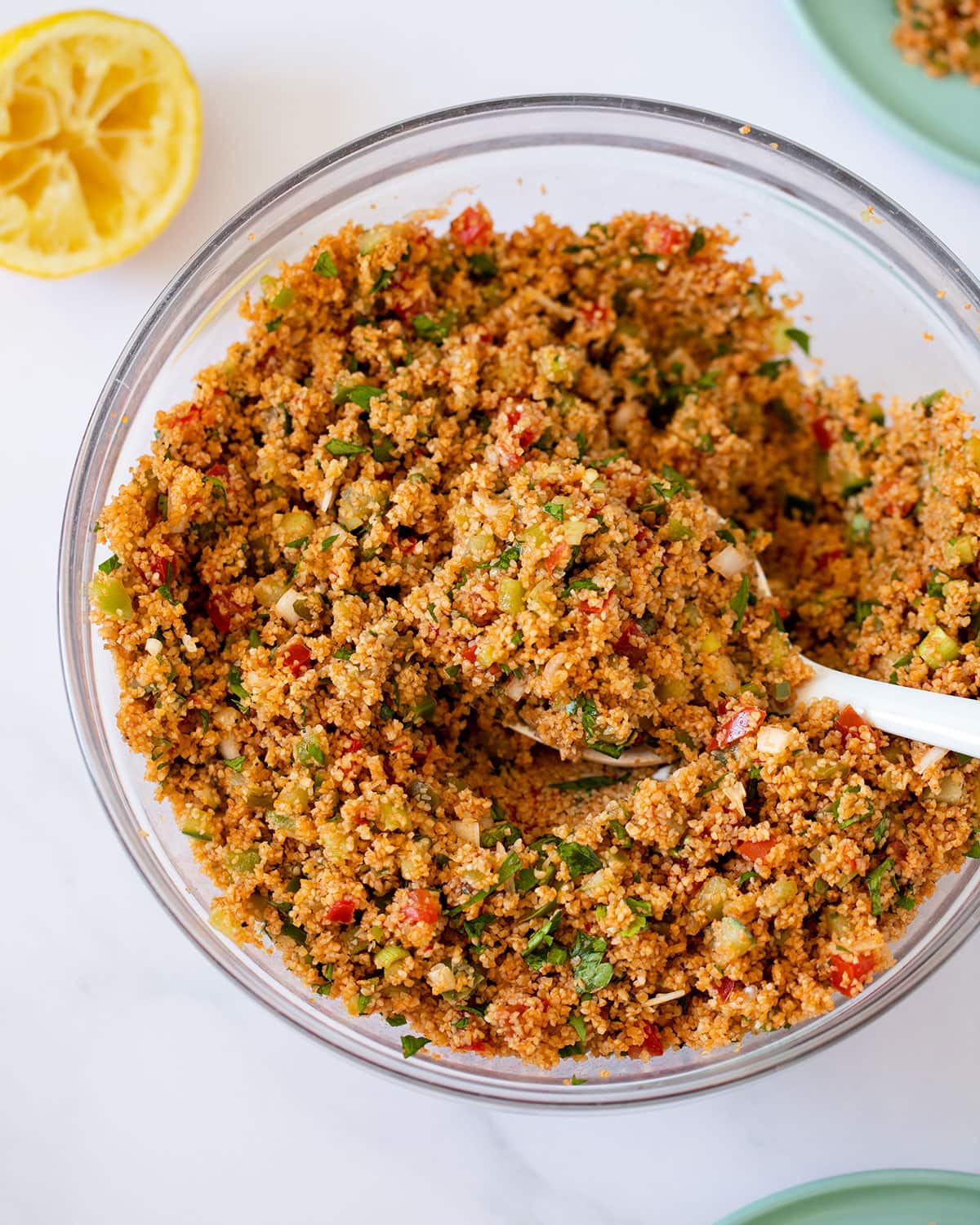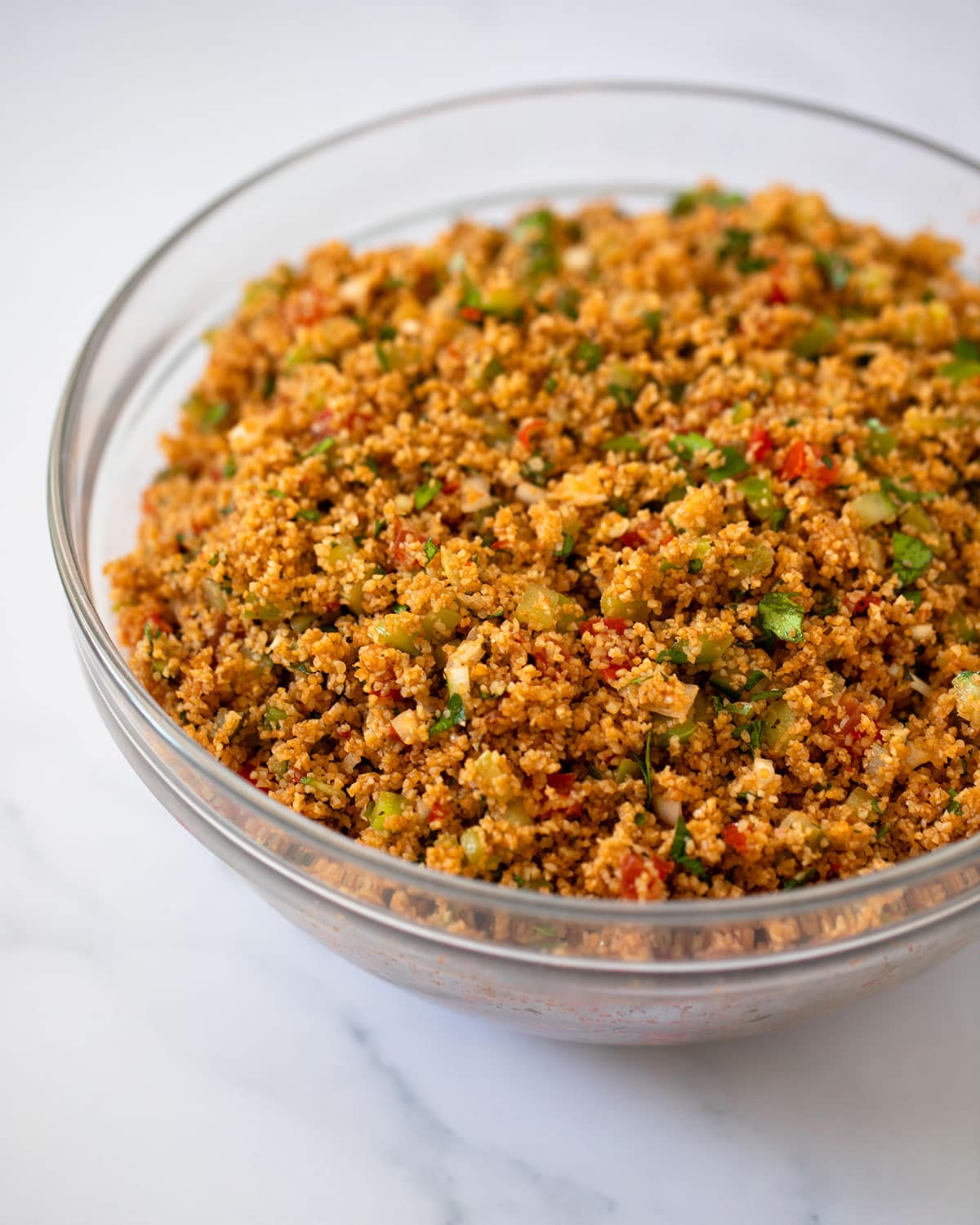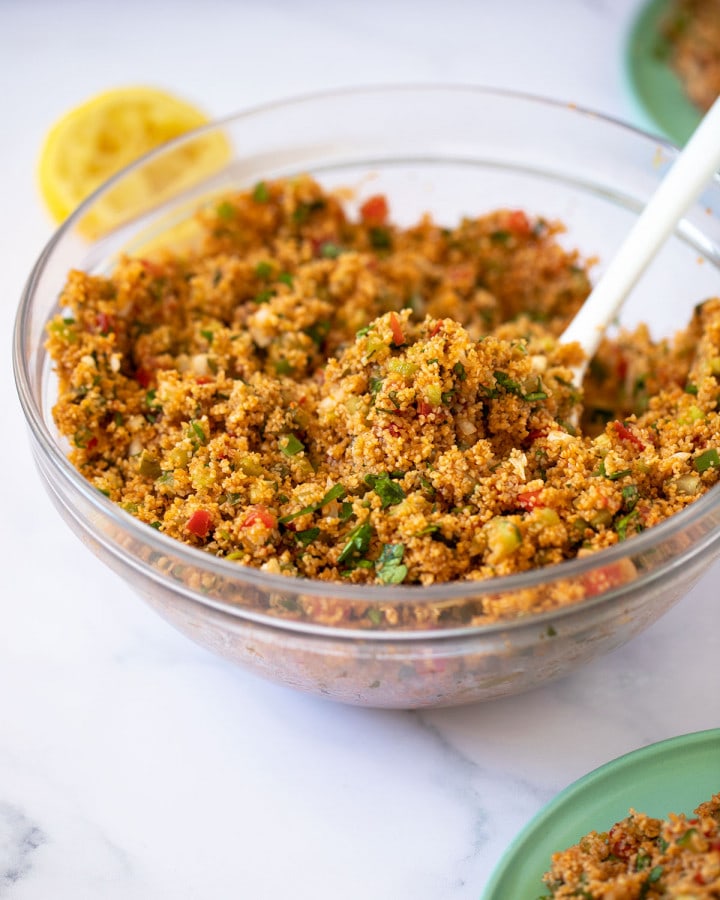Kisir (kısır) is a very refreshing Turkish bulgur salad. A close cousin to tabbouleh, it’s sweeter, tangier, and combines a lot more crunchy vegetables with less parsley. Kisir is the ultimate summery side as it would fit right in on any picnic table!
With kisir, I can promise you an explosion of flavors and textures. To accompany the nutty bulgur you have the crunchiness of pickles and cucumbers, the sweetness of peppers, tomatoes and onions, and a touch of sourness brought on by lemon juice and pomegranate molasses. It’s everything you dream of for a bulgur salad.
Big salad
One of my Turkish flatmates taught me how to make kisir when we were in college. We used to double the quantity and make huge batches of this delicious bulgur salad. It would last us for days! It was just the thing for students who only had time to cook several times a week. Plus, it would make us feel so healthy (all these chopped raw veggies!). It was definitely healthier than ordering in fast food, which we were prone to do often. Once I tried kisir I was completely smitten. There was no way I would go back to a dry and cold burger from McDonald’s.
We weren’t repeatedly making kisir just because it’s a great recipe for batch-cooking, but because it’s really tasty and fresh. Nothing beats it! I had to stop myself from making it all the time once I learned how to make it on my own. I was not afraid of getting bored with kisir (I don’t think you can) but I did want to expand my Turkish salad horizon while living there.
Types of bulgur
If you go to a Turkish shop or browse an online specialty food store, you’ll spot different types of bulgur. They are categorized by the coarseness of the cereal’s grain. The bulgur cooking method varies according to its coarseness, so it’s important to pick the right bulgur for this kisir recipe.
Here’s a rundown of the most common types of bulgur, from the finest to the coarsest:
- çiğ köftelik bulgur or köftelik ince bulgur (extra fine bulgur), used mostly to make bulgur patties called çiğ köfte
- köftelik bulgur or kısırlık bulgur (fine bulgur), that’s the one that is used to make kisir
- ince pilavlık bulgur or midyat bulgur (medium coarse bulgur), used mostly to make bulgur pilaf
- pilavlık bulgur (coarse bulgur)
- şehriyeli pilavlık bulgur (coarse bulgur with roasted vermicelli)
- iri pilavlık bulgur (extra coarse bulgur)
I usually buy bulgur from a brand called Duru and I’ve never been disappointed.

Substitutes for fine bulgur
Bulgur is wheat that has undergone cleaning, boiling, drying, grinding, and has then been sorted by size. Finding bulgur is tricky if you don’t live near a Turkish store and if you don’t want to order ingredients online. Finding fine bulgur can be even trickier! I doubt that you would find it in a supermarket, but you could have more chances in a health food store.
If you can’t find fine bulgur, the best substitute for kisir would be to use couscous. Couscous is tiny pasta made from semolina, traditionally used as a side for stews in North Africa. Couscous is so small that the cooking instructions for fine bulgur and couscous are identical, so you could follow the recipe without having to change a thing!
Couscous is not the same thing as Israeli pearl couscous. They are made from the same ingredients but pearl couscous balls are bigger and you can’t cook them the same way.
Step by step
This is an overview with step-by-step photos. The ingredient list and full instructions are in the recipe card below.
Step 1: Cook the fine bulgur

Put the bulgur into a large heatproof mixing bowl. Add the pastes and spices and stir until thoroughly combined. Stir in the water. Cover the bowl and let the bulgur sit for 15 min. Uncover the bulgur and fluff it with a fork to separate the grains. Voilà! Your fine bulgur is cooked and ready to be used for kisir.
Step 2: Make the salad

Deseed the vegetables and finely chop them all. Pour the lemon juice, olive oil, pickle juice, and pomegranate molasses over the fluffed bulgur and mix well. Stir in all the chopped ingredients. Serve the kisir straight away or refrigerate it cold.
Tomato and pepper pastes
Salça is a paste that is essential in Turkish cooking, as it’s used daily. If you go to a Turkish shop, you’ll always spot an aisle entirely dedicated to these red pastes (usually sold in glass jars). They are categorized by the types of vegetables used and their spiciness. The 5 different types of Turkish pastes are:
- domates salçası (tomato paste, very similar to the one you would find in your usual store)
- tatlı biber salçası (mild pepper paste)
- acı biber salçası (hot pepper paste)
- karışık salça (mix of tomato & mild pepper pastes)
- karışık salça az acılı (mix of tomato, mild & hot peppers pastes)
❗ Once you open a jar of salça, cover the top of the paste with a thin layer of olive oil and store it in the fridge. It’s important to always keep the top of the paste covered with oil to prevent it from getting moldy. Ensure the paste is completely covered after each use before returning it to the fridge. This way, the paste will keep for a very long time.
I usually refrain from buying the spicy pastes because I find it easier to achieve my preferred heat level by adding dry spices. I mostly use mild pepper paste in my Turkish recipes, but it comes down to personal preference. My favorite brands of salça pastes are Öncü and Öz Antep.
If you don’t feel like sourcing Turkish ingredients just to make kisir, feel free to replace both the Turkish tomato paste and the Turkish mild pepper paste with regular tomato paste instead.

Kisir
- Prep Time: 1 hour 20 minutes
- Cook Time: 15 minutes
- Total Time: 1 hour 35 minutes
- Yield: 4 servings 1x
- Category: Side dish
- Method: Soaking
- Cuisine: Turkish
- Diet: Vegetarian
Description
Kisir is a very refreshing Turkish bulgur salad. A close cousin to tabbouleh, it’s sweeter, tangier, and combines a lot more crunchy vegetables with less parsley. It’s the ultimate summery side as it would fit right in on any picnic table!
Ingredients
- 325 g fine bulgur (köftelik bulgur) (1 ¾ cups)
- 2 tsp fine table salt
- ½ tsp freshly ground black pepper
- 1 tsp dried mint (nane), or finely chop the leaves of 5 sprigs of mint
- pinch of red chili flakes (pul biber)
- 1 tbsp tomato paste (domates salçası)
- 1 tbsp mild pepper paste (tatlı biber salçası), or replace with tomato paste
- 3 tomatoes
- 1 small cucumber, or half of a long one
- 1 bullhorn green pepper, or use a small green bell pepper
- 5 spring onions
- 5 big pickles
- 15 sprigs of parsley
- 1 lemon, juiced
- 55 ml extra virgin olive oil (¼ cup)
- 2 tbsp pickle juice, from the jar
- 3 tbsp pomegranate molasses (nar ekşisi), or replace with 1 tbsp balsamic vinegar
Instructions
- Prepare the bulgur. Place the bulgur in a large mixing bowl. Add the salt, spices and pastes. Give everything a good stir with a wooden spoon until properly combined. Pour 295ml (1 ¼ cup) of just-boiled water over the bulgur and stir again. Cover the mixing bowl with plastic wrap, a tea towel or a plate and let the bulgur sit for 15 min. By this time, the bulgur will have cooked and absorbed the water.
- Chop all the vegetables and set them aside. Cut the tomatoes in half using a small sharp knife and cut under the seeds to remove them. Discard the seeds and cut the flesh into 5 mm (¼ in) cubes. Partially peel the cucumber skin into strips and cut the cucumber in half lengthways. Scoop out the seeds with a teaspoon and discard them. Cut the flesh into 5 mm (¼ in) cubes. Cut the green pepper in half lengthways and remove the seeds and the white membranes using the small sharp knife. Discard and cut the flesh into 5 mm (¼ in) cubes. Chop off the root ends of the spring onions and the green leaves and discard. Cut the bulbs and the stems into 5 mm (¼ in) cubes. Pick the parsley leaves off the stems, gather the leaves into a mound and finely chop them. Finely dice the pickles.
- Combine everything. Uncover the bulgur and fluff it with a fork to separate the grains. Pour the lemon juice, olive oil, pickle juice and pomegranate molasses over. Stir with a long wooden spoon. Add all the chopped ingredients and mix well. Taste to check the seasoning and adjust accordingly (you could add more salt, lemon juice, pickle juice, or pomegranate molasses). Serve straight away or cover the bowl with plastic wrap and refrigerate for a couple of hours (or until cold enough to your liking). I usually eat kisir as is, but it’s very common to serve it spooned on top of romaine lettuce leaves.
Notes
You can keep any leftovers for up to 4 days in the fridge, stored in an airtight container.
There is a more basic version of kisir that mainly consists of bulgur, tomato paste and finely chopped onions. It’s obviously faster because you don’t have as much chopping to do but I prefer the bulked-up version. It really turns kisir into a full meal.
Nutrition
- Serving Size: 1
- Calories: 495
Keywords: bulgur salad, side dish for picnic, summer vegetable salad, cold side dishes for summer
Do you want to try another refreshing Turkish salad? Here are some of my favorite recipes:

Leave a Reply